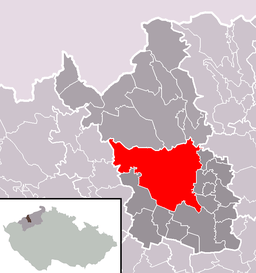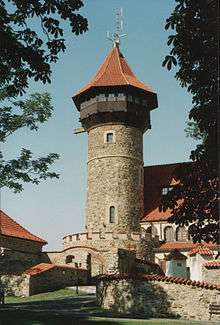Most (Most District)
| Most (Most District) | |||
| City | |||
| The only remaining street of old Most | |||
|
|||
| Name origin: bridge | |||
| Country | Czech Republic | ||
|---|---|---|---|
| Region | Ústí nad Labem | ||
| District | Most | ||
| River | Bílina | ||
| Elevation | 233 m (764 ft) | ||
| Coordinates | CZ 50°30′11″N 13°38′12″E / 50.50306°N 13.63667°ECoordinates: CZ 50°30′11″N 13°38′12″E / 50.50306°N 13.63667°E | ||
| Area | 86.94 km2 (34 sq mi) | ||
| Population | 67,089 (As of 2015) | ||
| Density | 772/km2 (1,999/sq mi) | ||
| First documented | 10th century | ||
| Mayor | Vlastimil Vozka | ||
| Timezone | CET (UTC+1) | ||
| - summer (DST) | CEST (UTC+2) | ||
| Postal code | 434 01 | ||
  Location in the Czech Republic | |||
 Location in Most District | |||
| Wikimedia Commons: Most | |||
| Website: The City of Most | |||
Most (Czech pronunciation: [ˈmost]; German: Brüx; Latin: Pons) is the capital city of the Most District, situated between the Central Bohemian Uplands and the Ore Mountains, approximately 77 km (48 mi) northwest of Prague along the Bílina River and southwest of Ústí nad Labem.
The name Most means "bridge" in Czech. The town, which was named after the system of bridges that crossed the swamps in this area in the 10th century, is now mostly known for its heavy industry. The German name for Most is Brüx (derived from the German word for "bridge", Brücke).
Most lies at the heart of the northern Bohemian lignite-mining region and serves as an important industrial railway junction. During the latter half of the 20th century, Most was considered to be one of the most polluted Coal mining towns in communist Czechoslovakia. Most's other industries includes textile, ceramics, steel, and chemicals.
Foreign mining operations continue to operate in the area in the 21st century. Some surrounding villages are planned to be abandoned due to surface mining. However environmental conditions have improved in recent years around Most, in particular the growing of apples and grape vines has developed.
History
Medieval period

The Latin Chronica Boemorum mentions a Slavic settlement below the Gnevin Castle called Gnevin Pons (Czech: Hněvínský most) in 1040. Through the swamps there led a merchant route from Prague to Freiberg. The network of wooden bridges was built to provide comfortable passages through this territory. Hneva from the Hrabišic dynasty established a military stronghold to protect caravans. Under this stronghold the village that would become Most developed.
In 1227 Kojata, the last of the Hrabisics, passed his property to the cloister of the Knights of the Cross. Since 1238 the royal town was owned by the Přemyslids and it became a rich city with many churches. The Bohemian kings Otakar II, John of Luxembourg, and Charles IV all granted Most city rights. In the 14th century, due to colonization, the city became predominantly German-populated and known as Brüx.
During the 15th and 16th centuries the city was hit by several fires. In around 1517, city reconstruction began the foundations of several significant facilities, including the new dean's church and the Renaissance city hall.
During the Thirty Years' War, the city was occupied by Swedish troops. Both in the early years and in the last years of the war it was captured by stratagem. In a similar manner the castle Hněvín was captured. After the Thirty Years' War, the city lost much of its economical and political significance.
19th century growth
In the second half of the 19th century industry and mining emerged, and in 1870, a railway line was built. Construction included sugar works, porcelain factory, steel works, brewery, and the founding of a city museum. In 1895 the city was affected by quicksand that swallowed several houses, including some of their occupants. In 1900 the RICO plant for dressing material was constructed. In 1901, an electric tramline linked Brüx with Kopitz up to Johnsdorf. The most modern theatre of its time within Austria-Hungary was opened in Brüx in 1911. The construction of a unique dam at Kreuzweg from 1911 to 1914 solved the city's problem with the supply of drinking water.
Until 1918, the town was part of the Austrian monarchy (Austria side after the compromise of 1867), head of the BRÜX district, one of the 94 Bezirkshauptmannschaften in Bohemia.[1]
WWII
On December 15, 1942, Brüx began output of Ersatz fuel synthesized from brown coal at the Sudetenländische Treibstoffwerke AG (STW) Maltheuren plant,[2][3] and a subcamp of Sachsenhausen provided forced labor. Stalag IV-C (Wistritz bei Teplitz) was at the "Sudentenland Treibstoff Werke",[4] and Brüx was repeatedly bombed during the Oil Campaign of World War II.
In 1945 Most was restored to Czechoslovakia and, following the expulsion of Germans after World War II (mainly 1946), Czechs replaced the Germans.
| Nations ruling Most | |
|---|---|
| Early | Hrabišic dynasty |
| 1238 | Přemyslid dynasty |
| ? | Kingdom of Bohemia |
| 1526 | Habsburg Monarchy |
| Thirty Years' War | Swedish Empire |
| 1806 | Austrian Empire |
| 1867 | Austria-Hungary |
| post–World War I | Czechoslovakia |
| 1938 | Nazi Germany |
| 1945 | Czechoslovakia |
| 1993 | Czech Republic |
Destruction & redevelopment
In 1964, the Most Coal Company began the demolition of the historical old town of Most in order to make room for the expanding lignite mines in the area. Financed and led by the communist government of Czechoslovakia, the company pulled down the town's historic buildings including a brewery dating from the 15th century and a theater built in 1910 and designed by Viennese architect Alexander Graf. New low-cost, standardized, multi-family housing projects were built, known as paneláky, the Czech word meaning "panels", referring to the precast concrete panels from which the buildings were erected. In the summer of 1968, an American film company shot scenes for the war film The Bridge at Remagen in the town; the clearance work providing realistic looking war-damaged properties.[5] The demolition work ended in 1970.[6]
Although the old town was flattened, the Communist authorities decided to preserve the Gothic Church of the Assumption of the Virgin Mary. The entire building, which was built between 1517 and 1594 and designed by Jakob Heilmann of Schweinfurt, was moved by train to the newly constructed town 2,759 feet [841 meters] away. The move took 28 days to complete at the rate of roughly 98 feet [30 meters] per day. The Czechoslovakian government took pride in the relocation of this religious structure, and the building was mentioned in the Guinness Book of World Records as the heaviest building ever moved on wheels.
Today most Czechs consider the decision to demolish Most as a destruction of Bohemian history and culture. Nevertheless, the redevelopment of the new town opened a new industrial era and opportunities in the area. Labor mobility drew skilled and unskilled labor to the mining and construction sectors in Most making it one of the busiest regions in Czechoslovakia.
Modern era
As a redeveloped city, Most does not have many historical sights, yet there are two important ones: Hněvín Castle and the Gothic Church of the Assumption of the Virgin Mary. On the other hand, there are many amusement facilities which can be visited: planetarium, observatory, autodrome, aquadrome or hippodrome.
Most is known for its huge share of people living in panelaks. The decimated environment along with urban development has given the outskirts of the city a depressing feeling.In 2007 a number of new developments were planned and construction began in the centre of the City. Of note are some small residential housing projects along with a major new shopping centre right in the centre. On the other side the concentration of population in the flats enabled remarkable development of informational technologies. For example, the cable television project functional in 1988 was something unusual in any other Czech city. Now many people have access to the broadband internet at prices well below average in the Czech Republic.
The new city is well-designed (wide streets, many parks in the center), especially the infrastructure and traffic situation is quite good in comparison with cities of similar size. The social situation of local people is bad. With the unemployment rate of nearly 25% (as of 2005) the locality is perhaps the worst in the Czech Republic. This is exacerbated by a huge workforce of aging unqualified miners. Also flat accommodation is quite cheap so it pushes more unemployed people from other regions to live there and raises this number. More recently, unemployment has been falling and government sources put the figure at around 15% in 2007.
Due to heavy social and European Union funding and the development of local business and industry, Most is beginning to recover.
The Hippodromo (Racecourse) in the Velebudice district of Most was the host of the 18th International Meeting of 2CV Friends between 28 July and 2 August 2009, attracting 3,333 vehicles and approximately 10,000 people.
Districts
- The neighborhood of Rudolice nad Bílinou is home to the Chánov housing estate, created during the communist era, which has become a symbol of the poverty and ghettoization of many Romani people in the Czech Republic.
- Vtelno used to be a village near Most. When the new city was built near it, Vtelno became an integral part of Most. It has a church, a historical Baroque manor, and many monoliths and sculptures that have been collected during the era of demolition of villages in the region (due to coal mining).
People
- Andreas Hammerschmidt (ca. 1611–1675), composer
- Florian Leopold Gassmann (1729–1774), composer
- Wenzel Hablik (1881–1934), painter and architect
- Heini Halberstam (1926–2014), mathematician
- Judita Čeřovská (1929–2001), singer
- Josef Masopust (born 1931), football player and coach
- Jan Mühlstein (born 1949), politician
- Pavel Chaloupka (born 1959), football player
- Vladimír Růžička (born 1963), ice hockey player
- Libor Pimek (born 1963), tennis player
- Petr Svoboda (born 1966), ice hockey player
- Martin Ručínský (born 1971), ice hockey player
- Jan Vopat (born 1973), ice hockey player
- Petr Franěk (born 1975), ice hockey player
- Vlastimil Kroupa (born 1975), ice hockey player
- Petr Johana (born 1976), football player
- Marek Židlický (born 1977), ice hockey player
- Pavel Rosa (born 1977), ice hockey player
- Kamil Piroš (born 1978), ice hockey player
- Tomáš Divíšek (born 1979), ice hockey player
- Markéta Jánská (born 1981), model
- Tomáš Kůrka (born 1981), ice hockey player
- Iveta Benešová (born 1983), tennis player
- Lukáš Kašpar (born 1985), ice hockey player
Neighboring cities and towns
International relations
Twin towns — Sister cities
Most is twinned with:
-
 Ekaterinburg, Sverdlovsk Oblast, Russia
Ekaterinburg, Sverdlovsk Oblast, Russia -
 Lahti, Finland
Lahti, Finland -
 Marienberg, Saxony, Germany
Marienberg, Saxony, Germany -
 Meppel, Drenthe, Netherlands
Meppel, Drenthe, Netherlands -
 Ptolemaida, Greece
Ptolemaida, Greece -
 Ulaanbaatar, Mongolia
Ulaanbaatar, Mongolia
References
- ↑ Die postalischen Abstempelungen auf den österreichischen Postwertzeichen-Ausgaben 1867, 1883 und 1890, Wilhelm KLEIN, 1967
- ↑ "HISTORY OF THE COMPANY". chemopetrol.cz.
- ↑ "Sudetenl ä ndische Treibstoffwerke AG Oberleutensdorf, Kreis Br ü x (Sudetengau) - Sudeten German factory for motor fuels akc. spol.". Translate.google.com. Retrieved 29 April 2009.
- ↑ "Summer 2002 Newsletter". The National Ex-Prisoner of War Association. 2002. Retrieved 12 October 2014.
- ↑ "American film-makers use Austrian tanks in Most". Euscreen.eu. Retrieved 24 August 2012.
- ↑ "Stary Most, Old city Most, Das Verschwundene Brux _1238-1982". YouTube.com. 2008-01-05. Retrieved 2015-03-30.
- Merriam Webster's Geographical Dictionary, 3rd edition
External links
| Wikisource has the text of the 1911 Encyclopædia Britannica article Brüx. |
- Demolition and construction of the city (Czech)
- Map of the city (Czech)
- Information for tourists and visitors of the city
| Wikimedia Commons has media related to Most. |

